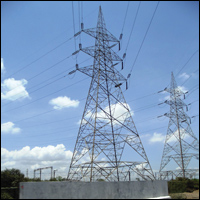Madhya Pradesh has joined the list of select states to introduce the public private partnership (PPP) model in intra-state power transmission. State power utility Madhya Pradesh Power Transmission Company Ltd (MPPTC) recently awarded a Rs.283-crore project to Mumbai-headquartered Kalpataru Power Transmission Ltd on design, build, finance, operate and transfer (DBFOT) mode. Speaking to Projectmonitor by phone from Jabalpur, a senior official of MPPTC confirmed that this was the state’s first power transmission project on PPP basis. “The project was structured using the Planning Commission’s Model Transmission Agreement,” the official, who did not wish to be identified, noted.
The concession agreement was signed in the first week of June and construction work on the project is likely to begin very soon. A wholly-owned subsidiary of Kalpataru Power Transmission will be the project implementing agency, technically referred to as the transmission service provider (TSP). The concession period would be for 25 years, with a provision of extending it by ten years.
The project involves setting up of a 400kV DCDS transmission line from Satpura to Ashta, with an estimated route length of around 246 km. Construction period is expected to be 15 months. The line, equipped with twin Moose ACSR conductors, will help evacuation from the 2×250-mw extension project of Madhya Pradesh Power Generation Company Ltd. The power generation project is under construction with commercial operations targeted for September this year.
It is interesting to note that MP did not follow the tariff-based bidding model per se, but instead went for a concept of “unitary charge,” as envisaged in the MTA. Simply put, this unitary charge is the monthly fee for provision of transmission services indicated upfront by the grantor of concession – in this case the state transmission utility. A bidder can put in a bid that is lower than the unitary charge, in which case the bidder would be paying a “premium,” or he can quote a higher unitary charge implying that the bidder is seeking a grant. This grant comes as Central assistance under the Viability Gap Funding (VGF) mechanism. The bidder quoting the lowest grant or highest premium is selected. In this manner, the bidding process retains the quintessential nature of tariff-based bidding without technically being so.
For this project, as the official explained, the response from bidders was encouraging. Kalpataru was selected as the bidder seeking the lowest grant. The project will get Central assistance of around 20 per cent of the project cost under the VGF mechanism. The state government will also spend a small amount on pre-project works, the state utility official indicated. “The state government will hold no equity stake in the project,” the official clarified.
MPPTC had earlier planned to develop this transmission line as its own project seeking loan from Power Finance Corporation Ltd. However, inspired by the success of Haryana that successfully deployed the aforementioned model for one of its projects, MP decided to toe the line. MPPTC is keen on extending the PPP culture to other transmission projects in the long run. A shelf of PPP projects is being created but it was too early to give out details, the official observed.
So far, states like Maharashtra, Uttar Pradesh, Haryana and Rajasthan have adopted the PPP philosophy for intra-state power transmission projects. Diverse modalities like joint venture, tariff-based bidding, etc. have been deployed. At the national level, PPP has been successfully used in ultra mega power transmission schemes with Reliance Infrastructure and Sterlite Grid being the selected developers. Foreign companies like Isolux Corsan and Cobra (both headquartered in Spain) are also developing intrastate power transmission lines in India. Both the companies, incidentally, have won independent concessions in Uttar Pradesh.
Speaking of PPP in state-level infrastructure, Madhya Pradesh has seen maximum success in state highways followed by urban infrastructure. In the power sector, the recently-awarded Satpura-Ashta line is the first instance; on the anvil are plans to privatize power distribution in the circles of Ujjain, Sagar and Gwalior.











